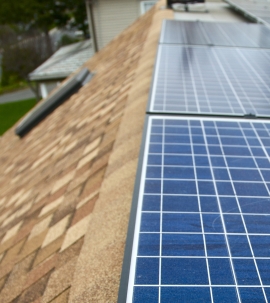Guest blog post by UK-based green living advocate Ben Saffer

A solar system – simplified
Solar power uses photovoltaic (PV) cells on the roof of your house to convert light from the sun into electrical energy which can be used in your house, or fed back into the national grid. A chemical reaction creates a flow of electrons in the solar panel (direct current or D/C), which feeds into an inverter to convert this into alternating current (A/C) to power your house.
Will it work if I don’t live in Southern California?
Solar panels don’t actually need sunshine to work, the photovoltaic cells react to daylight. So even on a completely overcast day solar panels can generate 40% of their potential electricity yield. And you are still connected to the electricity grid, so outside of daylight hours you can draw from the grid just as before. Plus, any extra electricity from your panels which you don’t use will be fed back to the grid and you’ll actually get paid for it! (See below)
The environmental benefits
The environmental case for renewable energy is becoming louder and more critical all the time. Barely a week goes by without a major news story involving the rising price of oil and gas, the terrible environmental impact of fossil fuel recovery methods such as “fracking†and tar sands which leave areas of land devastatingly polluted and emit up to 45% more greenhouse gas than even traditional oil and gas (and of course 100% more than solar). With peak oil production rapidly approaching, solar is widely seen as an integral part of the low-carbon future, and thankfully one which you can start to benefit from now.
The financial benefits
Arguably just as important as the environmental benefits, there are now real cost savings to be made by going solar. Government schemes both in the UK and US now provide homeowners with compelling cost incentives for installing solar panels at home. Last year in the UK the government introduced the Feed-in Tariff (FIT) as an incentive scheme to encourage homeowners to invest in solar PV.
in the UK, the FIT ensures payment of 43.3 pence (0.70 dollars) for each unit of electricity that their domestic solar system produces, irrespective of whether they use that electricity in their home or not. Additionally, the FIT also pays 3 pence (5 cents) per unit for electricity not used in the home and exported to the National Grid. The scheme is guaranteed for 25 years, and the amount will increase with inflation linked to the Retail Price Index.
With this in place, homeowners can make around £12,000 (US$19,500) profit over the lifecycle of their solar panels. This is on top of savings on electricity bills of between £70 (US$114) and £130 (US$212) every year.
Anything else to stop you?
Installation and all the technical know-how are handled by the solar panel provider, along with maintenance over the life of the panels. In the vast majority of cases you won’t require any planning permission to install solar panels. Although the initial cost of the panels is between £8,000 (US$13,000) and £14,000 (US$23,000), the feed-in-tariff, and bill savings ensure you will start earning this back from day one. Also, many solar panel providers offer free panels in exchange for rights to the feed-in-tariff until the cost is paid off. So there really should be nothing stopping you from going solar at home.
You should follow us here.






This is a great summation of the reasons to go PV. From energy use and utility bill reduction to government incentive programs, solar panel installations are becoming more viable. And as the technology gets better and more firms enter the production market, the prices will continue to drop.
It’s one of the myths about solar panels that they won’t work in cold climates but there has recently been some research carried out showing that solar radiation in Toronto is comparable to levels measured in Miami. So it really is true that you don’t have to live in California to spend your money on solar energy devices.